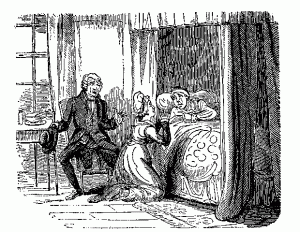08.14
On this date in 1751, Francis Blandy falls into a coma and dies in his home outside London, England. Later that night, Blandy’s daughter Mary offered one of the family’s servants a large sum of money to help her get to France immediately. Mary was forced to flee on her own when he refused, but she was chased down and caught by neighbors who had heard that Blandy had been poisoned. The servants in the Blandy home had been suspicious of Mary because the unmarried 26-year-old had been having an affair with William Cranstoun, a penniless man with a wife back in Scotland, against her father’s wishes. Cranstoun was determined to get a piece of the Blandy fortune. Blandy had initially approved of the match, even allowing Cranstoun to live in their house. But when Cranstoun wrote his wife and kindly asked if she wouldn’t mind disavowing their marriage, Mrs. Cranstoun became outraged and caused quite a local stir. Cranstoun was then abruptly tossed out of the house, yet Mary continued to see Cranstoun behind her father’s back. The couple, frustrated at their inability to touch Mary’s sizeable dowry, decided to find another route to the money. Mary began slipping small amounts of arsenic into her father’s food, slowly poisoning him over a period of months. As Blandy began to suffer from nausea and acute stomach pain, the servants grew suspicious. One found white powder in the bottom of a pan that Mary had used to feed her father. After Blandy eventually died, the cook saw Mary trying to dispose of the white powder and managed to preserve some of it. Mary was charged with murder and faced trial at Oxford Assizes in March 1752. Doctors testifying for the prosecution agreed that Francis Blandy had been poisoned with arsenic. But the test they used on the powder was rather unscientific: They heated it and smelled the vapors, which everyone agreed was clearly arsenic. It wasn’t until 40 years later that chemists finally developed true toxicology tests for arsenic. But the jury remained convinced, and Mary was sent to the gallows. She told the executioner, “Do not hang me too high, for the sake of decency.” Not long after Mary was executed, Cranstoun, who had escaped to France, died in poverty.
On this date in 1994, terrorist Illich Ramirez Sanchez, long known as Carlos the Jackal, is captured in Khartoum, Sudan, by French intelligence agents. Since there was no extradition treaty with Sudan, the French agents sedated and kidnapped Carlos. The Sudanese government, claiming that it had assisted in the arrest, requested that the United States remove their country from its list of nations that sponsor terrorism. Sanchez, who was affiliated with the Popular Front for the Liberation of Palestine, the Organization for Armed Arab Struggle, and the Japanese Red Army, was widely believed to be responsible for numerous terrorist attacks between 1973 and 1992. In 1974, he took the French ambassador and 10 others hostage at the Hague, demanding that French authorities release Yutaka Furuya of the Japanese Red Army. On June 27, 1975, French police officers tried to arrest Sanchez in a Paris apartment, but he killed two officers in an ensuing gun battle and escaped. In June 1992, Sanchez was tried in absentia for these murders and convicted. On December 21, 1975, Sanchez and a group of his men took 70 OPEC officials hostage at a Vienna conference. They made it to safety with somewhere between $25 million and $50 million in ransom money, but not before killing three hostages. Sanchez claimed responsibility for these crimes in an interview with the Arab magazine, Al Watan al Arabi. In the subsequent trial that resulted in his imprisonment, Sanchez was represented by Jacque Verges, who had reportedly helped to organize a failed rocket attack on a French nuclear power plant in 1982. Verges was also accused of sending a threatening letter from Sanchez to the French authorities so that Sanchez’s girlfriend (possibly his wife), German terrorist Magdalena Kopp, could be released. He bitterly denied the charges.














what in the world where they thinking?